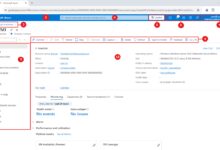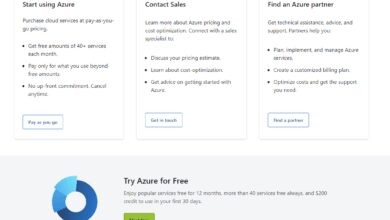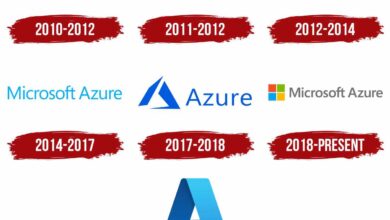MS Azure: 7 Powerful Reasons to Choose Microsoft’s Cloud
MS Azure isn’t just another cloud platform—it’s a powerhouse transforming how businesses operate globally. With unmatched scalability, enterprise-grade security, and seamless integration with Microsoft tools, it’s no wonder millions trust Azure for their digital future.
What Is MS Azure and Why It Matters

Microsoft Azure, commonly referred to as MS Azure, is a comprehensive cloud computing platform developed by Microsoft. Launched in 2010, it has rapidly evolved into one of the top three cloud service providers globally, alongside Amazon Web Services (AWS) and Google Cloud Platform (GCP). MS Azure offers over 200 services ranging from virtual machines and storage solutions to artificial intelligence and Internet of Things (IoT) capabilities.
Origins and Evolution of MS Azure
Azure began as Windows Azure, primarily focused on application hosting. Over the years, Microsoft rebranded and expanded its offerings significantly. By 2014, it was renamed Microsoft Azure to reflect its broader scope beyond just Windows-based applications. This shift marked Microsoft’s strategic pivot toward becoming a cloud-first company under CEO Satya Nadella.
- 2010: Launched as Windows Azure for developers to host .NET applications.
- 2014: Rebranded to Microsoft Azure with expanded services.
- 2018: Became the first cloud provider compliant with GDPR.
- 2020: Surpassed $50 billion in annual revenue, signaling massive enterprise adoption.
The platform now supports multi-platform environments, including Linux, open-source frameworks, and hybrid cloud setups, making it accessible to a diverse range of industries and developers.
Core Components of MS Azure
At its foundation, MS Azure operates on a global network of data centers. These are organized into regions and availability zones to ensure high availability and disaster recovery. The core components include compute, networking, storage, and identity management.
- Compute: Virtual Machines (VMs), Azure Functions (serverless), and Kubernetes Service (AKS).
- Networking: Virtual Networks, Load Balancers, and Azure DNS.
- Storage: Blob Storage, Disk Storage, and Data Lake.
- Security & Identity: Azure Active Directory (AAD), Key Vault, and Security Center.
These modular services allow organizations to build, deploy, and manage applications through a unified interface—whether on public, private, or hybrid clouds.
“Azure is not just infrastructure; it’s a platform for innovation.” — Satya Nadella, CEO of Microsoft
MS Azure vs. Competitors: A Strategic Edge
When comparing MS Azure to other major cloud providers like AWS and Google Cloud, several differentiators stand out. While AWS leads in market share, MS Azure excels in integration with existing enterprise ecosystems, especially those already using Microsoft products like Office 365, Dynamics 365, and Active Directory.
Integration with Microsoft Ecosystem
One of the biggest advantages of MS Azure is its native compatibility with Microsoft’s suite of productivity and business tools. For example, Azure Active Directory integrates seamlessly with Office 365, enabling single sign-on (SSO) and centralized user management across cloud and on-premises environments.
- Organizations using Microsoft 365 can leverage Azure AD for identity governance.
- Dynamics 365 customers benefit from Azure’s AI and analytics tools for customer insights.
- Hybrid environments are easier to manage due to Azure Arc and Windows Server integration.
This tight integration reduces complexity and training costs, making MS Azure an ideal choice for enterprises deeply invested in the Microsoft ecosystem.
Hybrid Cloud Leadership
Unlike AWS, which is primarily public cloud-focused, MS Azure leads in hybrid cloud solutions. Azure Stack allows businesses to run Azure services on-premises, giving them flexibility in data sovereignty, compliance, and latency-sensitive operations.
- Azure Stack HCI enables hyper-converged infrastructure for edge computing.
- Azure Arc extends cloud management to any environment—on-prem, multi-cloud, or edge.
- Disaster recovery is simplified with Azure Site Recovery.
According to a Microsoft report, over 95% of Fortune 500 companies use MS Azure, many leveraging its hybrid capabilities to modernize legacy systems without full migration.
Key Services Offered by MS Azure
MS Azure provides a vast array of services tailored to different business needs. From infrastructure as a service (IaaS) to platform as a service (PaaS) and software as a service (SaaS), Azure’s offerings cater to developers, IT administrators, data scientists, and business leaders alike.
Compute Services: Powering Applications
Azure’s compute services are designed for flexibility and performance. Whether you need persistent virtual machines or event-driven serverless functions, Azure delivers.
- Azure Virtual Machines: Scalable VMs available in Windows and Linux flavors.
- Azure App Service: Fully managed platform for web apps and APIs.
- Azure Functions: Serverless compute for lightweight, event-triggered tasks.
- Azure Kubernetes Service (AKS): Managed Kubernetes for container orchestration.
These services support DevOps workflows, enabling continuous integration and deployment (CI/CD) through tools like Azure DevOps and GitHub Actions.
AI and Machine Learning Capabilities
MS Azure stands out in the field of artificial intelligence. Azure Cognitive Services provide pre-built AI models for vision, speech, language, and decision-making.
- Computer Vision API analyzes images for content, faces, and text.
- Text Analytics detects sentiment, key phrases, and entities in unstructured text.
- Azure Machine Learning Studio allows data scientists to build custom models with drag-and-drop interfaces or code.
For example, companies like BMW use Azure AI to optimize manufacturing processes, while healthcare providers leverage it for medical imaging analysis. Microsoft also integrates OpenAI models (like GPT-3 and DALL-E) via Azure OpenAI Service, offering enterprises secure access to cutting-edge AI.
“Azure AI helps organizations turn data into actionable intelligence.” — Microsoft Azure AI Documentation
Security and Compliance in MS Azure
In today’s threat landscape, security is non-negotiable. MS Azure invests over $1 billion annually in cybersecurity and employs more than 3,500 security experts. This commitment ensures robust protection across physical, network, and application layers.
Built-In Security Features
MS Azure comes equipped with a suite of security tools designed to protect data and identities.
- Azure Security Center: Provides unified security management and advanced threat protection.
- Azure Defender: Extends Security Center with cloud workload protection.
- Azure Key Vault: Safely stores and manages cryptographic keys and secrets.
- Azure Firewall: Managed, cloud-native firewall service with threat intelligence.
These tools work together to detect anomalies, prevent breaches, and respond to incidents in real time. For instance, Azure Sentinel, a cloud-native SIEM (Security Information and Event Management) system, uses AI to analyze logs and detect suspicious activities across hybrid environments.
Global Compliance Standards
MS Azure complies with more regulatory standards than any other cloud provider. It supports over 140 compliance offerings, including GDPR, HIPAA, ISO 27001, SOC 1/2/3, and FedRAMP.
- Data residency options allow organizations to store data in specific geographic regions.
- Compliance Manager helps track and manage regulatory requirements.
- Audit logs and encryption at rest/in-transit ensure data integrity.
This makes MS Azure a preferred choice for highly regulated industries such as finance, healthcare, and government. A Microsoft Compliance page details all certifications and audit reports available to customers.
Cost Management and Pricing Models in MS Azure
Understanding MS Azure’s pricing is crucial for optimizing cloud spending. Unlike traditional IT models, Azure uses a pay-as-you-go structure, allowing businesses to scale resources up or down based on demand.
Flexible Pricing Tiers
MS Azure offers multiple pricing models to suit different usage patterns:
- Pay-As-You-Go: Ideal for startups and variable workloads—pay only for what you use.
- Reserved Instances: Save up to 72% by committing to 1- or 3-year terms for VMs and databases.
- Spot Instances: Use unused capacity at up to 90% discount for non-critical batch jobs.
- Hybrid Benefit: Apply existing Windows Server and SQL Server licenses to reduce costs.
The Azure Pricing Calculator is a powerful tool that helps estimate monthly costs before deployment. Additionally, Azure Cost Management + Billing provides real-time insights, budget alerts, and cost allocation by department or project.
Avoiding Cost Overruns
While the cloud offers flexibility, unmonitored usage can lead to unexpected bills. Best practices include:
- Setting up budgets and alerts in Azure Portal.
- Using tags to categorize resources (e.g., by environment: dev, test, prod).
- Automating shutdown schedules for non-production VMs.
- Regularly reviewing underutilized resources with Azure Advisor.
According to a Microsoft blog post, organizations that implement cost governance strategies save an average of 30% on their Azure bills.
Real-World Applications of MS Azure
MS Azure isn’t just theoretical—it powers real-world solutions across industries. From disaster recovery to AI-driven customer experiences, Azure enables digital transformation at scale.
Healthcare: Improving Patient Outcomes
Hospitals and clinics use MS Azure to securely store electronic health records (EHR), analyze medical imaging, and enable telemedicine platforms.
- Partners HealthCare uses Azure AI to predict patient deterioration in ICUs.
- Azure IoT Hub connects medical devices for real-time monitoring.
- Compliance with HIPAA ensures patient data privacy.
During the pandemic, Azure supported rapid deployment of vaccine management systems and virtual care platforms.
Retail: Personalizing Customer Experiences
Retailers leverage MS Azure to analyze shopping behavior, manage inventory, and deliver personalized recommendations.
- Walmart uses Azure to power its e-commerce platform and supply chain analytics.
- Azure Cognitive Services enable visual search and chatbots for customer service.
- Dynamics 365 + Azure integration provides end-to-end customer journey insights.
By combining data from online and in-store interactions, retailers gain a 360-degree view of their customers.
Getting Started with MS Azure: A Beginner’s Guide
Starting with MS Azure can seem overwhelming, but Microsoft provides extensive resources to help new users. Whether you’re a developer, IT pro, or business leader, there’s a path for you.
Setting Up Your First Azure Account
To begin, visit Azure Free Tier, which offers $200 in credits for 30 days and access to over 25 always-free services.
- Create an account using your Microsoft ID.
- Explore the Azure Portal dashboard.
- Deploy your first resource—like a Linux VM or a web app.
The free tier is perfect for learning, testing, and small projects without financial risk.
Learning Resources and Certifications
Microsoft Learn is a free, interactive platform offering guided learning paths for Azure.
- AZ-900: Microsoft Azure Fundamentals – Entry-level certification for beginners.
- AZ-104: Azure Administrator – For IT professionals managing cloud infrastructure.
- AZ-204: Developing Solutions for Azure – For developers building cloud-native apps.
These certifications are recognized globally and can boost career prospects in cloud computing.
Future Trends Shaping MS Azure
MS Azure continues to evolve with emerging technologies. From quantum computing to edge AI, Microsoft is investing heavily in next-generation innovations.
Edge Computing and Azure IoT Edge
Azure IoT Edge allows AI models and data processing to occur on devices at the edge of the network, reducing latency and bandwidth usage.
- Used in manufacturing for predictive maintenance.
- Enables real-time video analytics in security cameras.
- Supports autonomous vehicles and smart cities.
With 5G rollout accelerating, edge computing will become even more critical, and MS Azure is positioned to lead this shift.
Quantum Computing with Azure Quantum
Azure Quantum is a full-stack cloud ecosystem for quantum computing research and development.
- Provides access to quantum hardware from partners like IonQ and Quantinuum.
- Offers Q# programming language and simulators for algorithm development.
- Targets complex problems in chemistry, logistics, and cryptography.
While still in early stages, quantum computing could revolutionize industries, and MS Azure is making it accessible to researchers and enterprises today.
What is MS Azure?
MS Azure is Microsoft’s cloud computing platform that provides a wide range of services including computing, storage, networking, databases, AI, and security. It enables businesses to build, deploy, and manage applications across a global network of data centers.
How does MS Azure compare to AWS?
While AWS has the largest market share, MS Azure excels in hybrid cloud integration, enterprise compatibility (especially with Microsoft 365), and compliance. Azure is often preferred by organizations already using Microsoft products.
Is MS Azure free to use?
MS Azure offers a free tier with $200 in credits for 30 days and access to many always-free services. This allows users to explore and learn Azure without upfront costs.
What industries use MS Azure?
MS Azure is used across healthcare, finance, retail, government, education, and manufacturing. Its compliance, security, and AI capabilities make it suitable for regulated and data-intensive sectors.
How can I get certified in MS Azure?
You can earn Azure certifications through Microsoft Learn. Start with AZ-900 (Azure Fundamentals), then progress to role-based exams like AZ-104 (Administrator) or AZ-204 (Developer). Training modules and practice tests are available online.
MS Azure has firmly established itself as a leader in the cloud computing space. Its blend of enterprise integration, hybrid flexibility, robust security, and cutting-edge AI makes it a compelling choice for organizations of all sizes. Whether you’re migrating legacy systems, building modern apps, or exploring AI and quantum computing, MS Azure provides the tools and infrastructure to succeed. With continuous innovation and a vast global footprint, the future of MS Azure looks not just bright—but transformative.
Further Reading:









